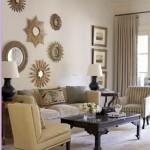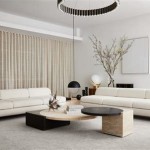Open Kitchen and Living Room Decor
Open-concept kitchens and living rooms have become increasingly popular in modern home design. This layout creates a sense of spaciousness and facilitates interaction between family members and guests. However, designing a cohesive and functional space requires careful planning and consideration of décor elements to ensure both areas complement each other seamlessly.
One of the primary considerations for open-plan living is establishing a consistent design language. This can be achieved through a unified color palette that flows throughout both the kitchen and living room. Using similar shades or complementary colors on walls, furniture, and accessories creates a sense of visual harmony. For instance, a neutral base color such as white or gray can be accented with pops of color in artwork, cushions, or kitchen accessories. This creates a cohesive and visually appealing space.
Flooring also plays a crucial role in unifying the space. Opting for a continuous flooring material throughout both areas creates a sense of flow and visually expands the space. Consistent flooring materials, such as hardwood or tile, contribute to the seamless transition between the kitchen and living areas. While area rugs can be used to define specific zones, such as the living room seating area, they should complement the overall flooring and color scheme.
Furniture selection and placement are essential for defining zones within an open-plan layout. While the space is open, it's important to create distinct areas for different activities, such as cooking, dining, and relaxing. Carefully positioned furniture, like a strategically placed sofa or a kitchen island with bar seating, can act as natural dividers, delineating the kitchen from the living area without disrupting the open flow.
Lighting is another crucial design element. A well-lit space enhances both functionality and aesthetics. Layered lighting, incorporating ambient, task, and accent lighting, provides both practicality and ambiance. Ambient lighting, such as recessed lighting or pendant lights, illuminates the entire space. Task lighting, like under-cabinet lighting in the kitchen, provides focused light for specific activities. Accent lighting, like strategically placed table lamps or wall sconces, highlights artwork or architectural features, adding depth and warmth to the space.
Maintaining a consistent style throughout both areas is key to creating a harmonious aesthetic. Whether the preferred style is modern, farmhouse, or traditional, carrying design elements through both the kitchen and living room ensures a cohesive look. This could involve using similar cabinetry styles, hardware finishes, and decorative accents.
Incorporating natural elements, such as plants, wood, and stone, can enhance the connection between the kitchen and living room. These elements bring a sense of the outdoors in and create a more relaxing and inviting atmosphere. Plants can be used strategically to add pops of color and texture, while wood accents can add warmth and visual interest. Stone or brick elements can be incorporated through backsplashes, fireplaces, or accent walls.
The use of textiles can contribute to the overall aesthetic and create a sense of warmth and comfort. Incorporating cushions, throws, and curtains in complementary colors and textures can add personality and style to the space. Consider using similar fabrics or patterns in both areas to create a cohesive look.
Storage solutions should be considered carefully in an open-plan setting. Clutter can quickly detract from the overall aesthetic, so maximizing storage is crucial. Incorporating built-in shelving, cabinets, and drawers can help keep the space organized and visually appealing. Utilizing decorative baskets and boxes can also provide stylish storage solutions.
Focal points are essential for drawing the eye and creating visual interest. In an open-plan layout, a focal point can be a statement piece of furniture, a fireplace, a large piece of artwork, or a unique architectural feature. This creates a visual anchor and helps to balance the space.
Consider traffic flow when planning the layout. Ensure there is ample space for movement between the kitchen and living room. Furniture placement should not obstruct walkways or create bottlenecks. A clear and unobstructed path between the two areas is essential for functionality and safety.
Personal touches are what make a house a home. Incorporating personal items, such as family photos, travel souvenirs, or cherished collections, adds character and warmth to the space. These personal touches help to create a unique and inviting atmosphere that reflects the personalities of those who live there.
Regular decluttering is crucial for maintaining a clean and organized space, especially in an open-plan layout where clutter is easily visible. Regularly decluttering surfaces, countertops, and shelves helps to keep the space looking its best and creates a more relaxing environment.

17 Open Concept Kitchen Living Room Design Ideas Style Motivation Farm House Contemporary Farmhouse

Before After Open Concept Kitchen And Living Room Decorilla
.jpg?strip=all)
5 Design Savvy Ideas For Open Concept Living Room And Kitchen

Open Kitchen Designs With Living Room In Designcafe

Open Concept Kitchen And Living Room 55 Designs Ideas Interiorzine

18 Great Room Ideas Open Floor Plan Decorating Tips

Open Concept Kitchen And Living Room Décor Modernize

Open Concept Kitchen And Living Room 55 Designs Ideas Interiorzine

Bring Kitchen Living Room Design Ideas To Life

Open Concept Kitchen Living Room Design Ideas







